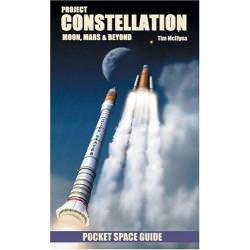Humankind has five senses. Though eyesight provides us with most of our information, truly believing usually relies on the tactile sense. Thus people go to low Earth orbit, the Moon and soon, hopefully, to Mars. Two new books from Apogee highlight the craft that get the privilege of sending a few lucky members of our species into space.
The space shuttle is today’s workhorse for placing man and machine into space, as Robert Godwin shows in Apogee’s pocket guide Space Shuttle – Fact Archive. But we aren’t content with living in today’s glories, thus we plan for tomorrow. For this, Tim McElyea lays out the next transport system in the pocket guide Project Constellation – Moon, Mars and Beyond. Both these two guides have a thorough collection of notes and pictures to help every future space traveller know how our senses lead us into understanding.
The first guide book is on the space shuttle. These re-useable craft rocket into low Earth orbit, partake in experiments or engineering feats, then glide back to the surface. Up to eight travellers can ascend and help with the tasks in orbit. Physics, life sciences and crystal growth have been subjects of studies within the orbiter. Outside, it has launched space-telescopes and satellites as well as undertaken a number of servicing jobs to keep equipment operating.
Godwin’s space shuttle guide hints at the tasks undertaken in orbit, however, the book’s focus is on the shuttle and the crew. As the first chapter states, it’s about shuttle basics. A page or two describes the solid rocket boosters, the external fuel tank, the engines and the orbiter. Next are a few pages for each of the five operational orbiters, including construction milestones and noteworthy flights. The last part of the text describes some standard payload containers; the Spacehab and Spacelab pallet. These provide a concise but limited view into the shuttle as a technology marvels.
In the book, following the description of the shuttle, are ordered lists of some of the shuttle flights. These are sparse, just titles. Filling the majority of the final pages are all the official crew photographs, together with the crew’s names and the mission badge.
Though this guide relates directly to the shuttle, its focus isn’t clear, as realized by the mix of technical details and crew portraits. Much more could be made of the shuttle’s technical details and accomplishments in flight. On the other side, the same goes for describing the crews. The presence in the guide appears like a sports card collection without insight into the people who flew the craft. The guide is, at best, a light reference that could encourage an unaware reader to learn more.
The book Space Shuttle – Fact Archive hints at the incredible accomplishments achieved by the space shuttle. But, it is more a reference list than a fact archive. Nevertheless, this book reinforces the fact that a technological marvel built by humankind has sent many people to undertake valuable work in space.
Where the pocket guide on the shuttle had the ease of describing an existing craft, McElyea has the challenge of guessing the future. His book, Project Constellation – Moon, Mars and Beyond, targets the craft planned to go to Mars. Hence, with Project Constellation still on the drawing boards, McElyea’s quick to admit his guide won’t be definitive. But in it, he does cover much of the current plan.
At the start of the book, McElyea describes the expected ‘plan of attack’. This is to use an Earth orbit rendezvous that couples a cargo vehicle with a crew vehicle. The combined craft then goes onto its destination. Next, he outlines the Ares Cargo Launch vehicle, then moves on to discuss the Orion Crew Exploration Vehicle. He also includes a little on schedules and trade-off studies but, principally, he stays with what is known and accepted for this project.
Given the state of the project, most of the text regards system level requirements and the plans or equipment slated to meet them. For example, big low-risk engines will need to propel the craft, so the J-2X is proposed. Separate cargo and passenger vehicles minimize costs due to human-rating. And, the trip to Mars will require a large mass to support a crew for the years of flight. Actually, in spite of the conceptual nature of the project, the book provides clear and logical descriptions of many elements and missions.
The graphic section of this guide well matches the text section. Most images are of artists’ rendering rather than photographs. But they still give a good feel for the magnitude of the project and the planned rockets. Outlines of mission stages provide an equally vivid portrayal of what these craft are to accomplish. There’s even a few images of ongoing tests, such as wind tunnel tests of Ares. The resulting blend between realism and expectation gives the reader a warm feeling of progress toward operations.
The next manned mission for NASA is to the moon, then on to Mars. Tim McElyea’s guide Project Constellation – Moon, Mars and Beyond layouts the basic project elements. From this, the reader can see that humankind’s senses will be continually rewarded with extraordinary receptions.

